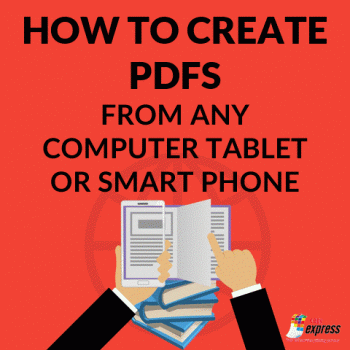

Use our online designer studio to create your own personalised flyers, business cards, greeting cards and more.
Order NowWhen it comes to professional printing and advice on your business marketing, we are the team to call! You can call us direct on 04 568 8773 or fill in our quote form.
Request a Quote
Everyone knows what a PDF is, every brochure you find online, every manual you don’t find in the box, books you read on your phone or tablet, PDF’s are everywhere. A lot of computer programs you use will let you save your work to PDFs ready for reading on the screen and sending to printing professionals, like us here at Copy Express. But what if you’ve never been shown how to create a PDF, or are unsure how to get the best results. This short article is going to give you what you need to know.
Go into the File menu. Depending on the program it will be found under the Save As, Export or Print options.
Many businesses use cloud computing based software (Google Office / Microsoft Office 365 / etc) so that they can use any internet connected device to do their work, be it computer, tablet, or phone. Much like their computer only counterparts they will have some form of PDF saving function built in, normally under the File menu as Download or Print and they work the same way, but they may also hide it under the Share button. If it’s under the share button, things will work a little differently.
The next step is to see if your operating system has a PDF printer built in. Windows / Mac / Linux all have one as standard these days. It’s just another printer you can pick from the lists of printers when you print something from your application. If you don’t have that there are other options to get around it.
Option one is to install a Print to PDF printer application on your system. These come in a variety of formats for every operating system and there are, free, freemium (free but you have to pay to get access to some features), and commercial options. Some are basic printer stand-ins, middle of the range have the ability to ‘drag and drop’ a large selection of file types and convert them for you. The most advanced allow you to edit the pdfs and add things like fill in fields and password encryption. There are far too many to list here but a quick net search for ‘Print to PDF reviews’ will bring up a batch of pages for you to have a look through and help you find the one that fits your needs.
The second option is using an online based converter. These are websites where you can upload or drag and drop a file and they will generate a PDF from it. Depending on the site you can download it or it’s emailed to you. I’m sure you can already see the problems in using this type of system. You don’t know who has access to the files while being processed and it could be a major privacy risk. I would generally avoid them unless you are very familiar with internet safety and aren’t worried about the risk of others seeing what you are converting.
The third option is us. That’s right Copy Express. Not only do we have very advanced PDF software as part of our tool set, we also have access to a wide range of applications that will read most file formats natively. We can do it at the office while you wait, or just email the files to us and we will take care of the rest. We only charge for the time we have to physically spend doing things we have largely automated the process. Another advantage is we can convert physical media like paperwork, books, posters and some film media into digital form too. Depending on what it is, it can even become ‘machine readable’ which means you can then edit the text.
That depends on who is getting the file. Most of the systems come with fairly limited options. If it’s being Exported or Save As you might not have any choice other than picking where the file is saved and what name to use. Many of them do have a standard and a screen/on-line quality option. Standard quality leaves the file as it is, while screen compresses the file so you get a smaller document to send which is fine to read on a screen but will look quite blocky/grainy if printed out. The more advanced ones will let you pick a dpi (dots per inch) or dpcm (dots per centimetre) value that says how much detail is in the file. If it’s only for screen use then upto 150 dpi / 60 dpcm is fine. If you want to send things to Copy Express to print, then the absolute minimum is 200 dpi / 80 dpcm, but you’ll get much better results at 300 dpi / 120 dpcm. That’s all you need to do and we will have a file that’s ready to print.
That’s it, all you need to know to be able to create pdfs from any type of program on any type of computer, tablet, or phone. If you do get stuck, give as a call or email and we will be glad to help you out.